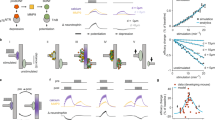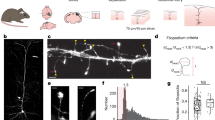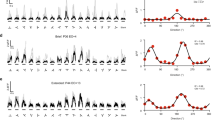Abstract
Single neocortical neurons are driven by populations of excitatory inputs, which form the basis of neuronal selectivity to features of sensory input. Excitatory connections are thought to mature during development through activity-dependent Hebbian plasticity1, whereby similarity between presynaptic and postsynaptic activity selectively strengthens some synapses and weakens others2. Evidence in support of this process includes measurements of synaptic ultrastructure and in vitro and in vivo physiology and imaging studies3,4,5,6,7,8. These corroborating lines of evidence lead to the prediction that a small number of strong synaptic inputs drive neuronal selectivity, whereas weak synaptic inputs are less correlated with the somatic output and modulate activity overall6,7. Supporting evidence from cortical circuits, however, has been limited to measurements of neighbouring, connected cell pairs, raising the question of whether this prediction holds for a broad range of synapses converging onto cortical neurons. Here we measure the strengths of functionally characterized excitatory inputs contacting single pyramidal neurons in ferret primary visual cortex (V1) by combining in vivo two-photon synaptic imaging and post hoc electron microscopy. Using electron microscopy reconstruction of individual synapses as a metric of strength, we find no evidence that strong synapses have a predominant role in the selectivity of cortical neuron responses to visual stimuli. Instead, selectivity appears to arise from the total number of synapses activated by different stimuli. Moreover, spatial clustering of co-active inputs appears to be reserved for weaker synapses, enhancing the contribution of weak synapses to somatic responses. Our results challenge the role of Hebbian mechanisms in shaping neuronal selectivity in cortical circuits, and suggest that selectivity reflects the co-activation of large populations of presynaptic neurons with similar properties and a mixture of strengths.
This is a preview of subscription content, access via your institution
Access options
Access Nature and 54 other Nature Portfolio journals
Get Nature+, our best-value online-access subscription
$29.99 / 30 days
cancel any time
Subscribe to this journal
Receive 51 print issues and online access
$199.00 per year
only $3.90 per issue
Buy this article
- Purchase on Springer Link
- Instant access to full article PDF
Prices may be subject to local taxes which are calculated during checkout




Similar content being viewed by others
Data availability
An example electron microscopy image volume is publicly available at https://mpfi.org/download/mpfi-20200401-ferret-v1-ds1. Data presented in Fig. 2 and Extended Data Fig. 3 are available at https://github.com/schollben/StructFuncEM2020. Additional data and published data are available from the corresponding author upon reasonable request.
Code availability
Code is available from the corresponding author upon reasonable request. The NEURON modelling script is available from https://github.com/schollben/StructFuncEM2020.
Change history
01 February 2021
A Correction to this paper has been published: https://doi.org/10.1038/s41586-020-03158-8
References
Miller, K. D. in Models of Neural Networks III (eds Domany, E. et al.) 55–78 (Springer, 1996).
Abbott, L. F. & Nelson, S. B. Synaptic plasticity: taming the beast. Nat. Neurosci. 3 (Suppl), 1178–1183 (2000).
Bartol, T. M. et al. Nanoconnectomic upper bound on the variability of synaptic plasticity. eLife 4, e10778 (2015).
Harris, K. M. Structure, development, and plasticity of dendritic spines. Curr. Opin. Neurobiol. 9, 343–348 (1999).
Tanaka, J. et al. Protein synthesis and neurotrophin-dependent structural plasticity of single dendritic spines. Science 319, 1683–1687 (2008).
Cossell, L. et al. Functional organization of excitatory synaptic strength in primary visual cortex. Nature 518, 399–403 (2015).
Lee, W.-C. A. et al. Anatomy and function of an excitatory network in the visual cortex. Nature 532, 370–374 (2016).
El-Boustani, S. et al. Locally coordinated synaptic plasticity of visual cortex neurons in vivo. Science 360, 1349–1354 (2018).
Scholl, B., Wilson, D. E. & Fitzpatrick, D. Local order within global disorder: synaptic architecture of visual space. Neuron 96, 1127–1138 (2017).
Denk, W. & Horstmann, H. Serial block-face scanning electron microscopy to reconstruct three-dimensional tissue nanostructure. PLoS Biol. 2, e329 (2004).
Arellano, J. I., Benavides-Piccione, R., Defelipe, J. & Yuste, R. Ultrastructure of dendritic spines: correlation between synaptic and spine morphologies. Front. Neurosci. 1, 131–143 (2007).
Kasthuri, N. et al. Saturated reconstruction of a volume of neocortex. Cell 162, 648–661 (2015).
Wilson, D. E., Whitney, D. E., Scholl, B. & Fitzpatrick, D. Orientation selectivity and the functional clustering of synaptic inputs in primary visual cortex. Nat. Neurosci. 19, 1003–1009 (2016).
Hering, H. & Sheng, M. Dendritic spines: structure, dynamics and regulation. Nat. Rev. Neurosci. 2, 880–888 (2001).
Bourne, J. N. & Harris, K. M. Coordination of size and number of excitatory and inhibitory synapses results in a balanced structural plasticity along mature hippocampal CA1 dendrites during LTP. Hippocampus 21, 354–373 (2011).
Toni, N., Buchs, P. A., Nikonenko, I., Bron, C. R. & Muller, D. LTP promotes formation of multiple spine synapses between a single axon terminal and a dendrite. Nature 402, 421–425 (1999).
Araya, R., Jiang, J., Eisenthal, K. B. & Yuste, R. The spine neck filters membrane potentials. Proc. Natl Acad. Sci. USA 103, 17961–17966 (2006).
Hines, M. L., Davison, A. P. & Muller, E. NEURON and Python. Front. Neuroinform. 3, 1 (2009).
Sobczyk, A., Scheuss, V. & Svoboda, K. NMDA receptor subunit-dependent [Ca2+] signaling in individual hippocampal dendritic spines. J. Neurosci. 25, 6037–6046 (2005).
Losonczy, A. & Magee, J. C. Integrative properties of radial oblique dendrites in hippocampal CA1 pyramidal neurons. Neuron 50, 291–307 (2006).
Harvey, C. D. & Svoboda, K. Locally dynamic synaptic learning rules in pyramidal neuron dendrites. Nature 450, 1195–1200 (2007).
Buzsáki, G. & Mizuseki, K. The log-dynamic brain: how skewed distributions affect network operations. Nat. Rev. Neurosci. 15, 264–278 (2014).
Hofer, S. B., Mrsic-Flogel, T. D., Bonhoeffer, T. & Hübener, M. Experience leaves a lasting structural trace in cortical circuits. Nature 457, 313–317 (2009).
Kirchner, J. H. & Gjorgjieva, J. A unifying framework for synaptic organization on cortical dendrites. Preprint at https://doi.org/10.1101/771907 (2019).
Alonso, A., de Curtis, M. & Llinás, R. Postsynaptic Hebbian and non-Hebbian long-term potentiation of synaptic efficacy in the entorhinal cortex in slices and in the isolated adult guinea pig brain. Proc. Natl Acad. Sci. USA 87, 9280–9284 (1990).
Nishiyama, J. & Yasuda, R. Biochemical computation for spine structural plasticity. Neuron 87, 63–75 (2015).
Feldmeyer, D., Egger, V., Lubke, J. & Sakmann, B. Reliable synaptic connections between pairs of excitatory layer 4 neurones within a single ‘barrel’ of developing rat somatosensory cortex. J. Physiol. 521, 169–190 (1999).
Feldmeyer, D., Lübke, J., Silver, R. A. & Sakmann, B. Synaptic connections between layer 4 spiny neurone-layer 2/3 pyramidal cell pairs in juvenile rat barrel cortex: physiology and anatomy of interlaminar signalling within a cortical column. J. Physiol. 538, 803–822 (2002).
Markram, H., Lübke, J., Frotscher, M., Roth, A. & Sakmann, B. Physiology and anatomy of synaptic connections between thick tufted pyramidal neurones in the developing rat neocortex. J. Physiol. 500, 409–440 (1997).
Holler-Rickauer, S., Koestinger, G., Martin, K. A. C., Schuhknecht, G. F. P. & Stratford, K. J. Structure and function of a neocortical synapse. Pre print at https://doi.org/10.1101/2019.12.13.875971 (2019).
Nicholson, D. A. et al. Distance-dependent differences in synapse number and AMPA receptor expression in hippocampal CA1 pyramidal neurons. Neuron 50, 431–442 (2006).
Peirce, J. W. PsychoPy–psychophysics software in Python. J. Neurosci. Methods 162, 8–13 (2007).
Pologruto, T. A., Sabatini, B. L. & Svoboda, K. ScanImage: flexible software for operating laser scanning microscopes. Biomed. Eng. Online 2, 13 (2003).
Pnevmatikakis, E. A. & Giovannucci, A. NoRMCorre: An online algorithm for piecewise rigid motion correction of calcium imaging data. J. Neurosci. Methods 291, 83–94 (2017).
Sage, D., Prodanov, D. & Tinevez, J. Y. MIJ: making interoperability between ImageJ and Matlab possible. http://bigwww.epfl.ch/publications/sage1205.html (2012).
Kerlin, A. et al. Functional clustering of dendritic activity during decision-making. eLife 8, e46966 (2019).
Scholl, B., Pattadkal, J. J., Dilly, G. A., Priebe, N. J. & Zemelman, B. V. Local integration accounts for weak selectivity of mouse neocortical parvalbumin interneurons. Neuron 87, 424–436 (2015).
Scholl, B., Tan, A. Y. Y., Corey, J. & Priebe, N. J. Emergence of orientation selectivity in the Mammalian visual pathway. J. Neurosci. 33, 10616–10624 (2013).
Takumi, Y., Ramírez-León, V., Laake, P., Rinvik, E. & Ottersen, O. P. Different modes of expression of AMPA and NMDA receptors in hippocampal synapses. Nat. Neurosci. 2, 618–624 (1999).
Fiala, J. C. & Harris, K. M. Cylindrical diameters method for calibrating section thickness in serial electron microscopy. J. Microsc. 202, 468–472 (2001).
Starborg, T. et al. Using transmission electron microscopy and 3View to determine collagen fibril size and three-dimensional organization. Nat. Protoc. 8, 1433–1448 (2013).
Hughes, L., Hawes, C., Monteith, S. & Vaughan, S. Serial block face scanning electron microscopy-the future of cell ultrastructure imaging. Protoplasma 251, 395–401 (2014).
Cardona, A. et al. TrakEM2 software for neural circuit reconstruction. PLoS ONE 7, e38011 (2012).
Lowe, G. SIFT-the scale invariant feature transform. Int. J. Comput. Vis. 60, 91–110 (2004).
Belevich, I., Joensuu, M., Kumar, D., Vihinen, H. & Jokitalo, E. Microscopy image browser: A platform for segmentation and analysis of multidimensional datasets. PLoS Biol. 14, e1002340 (2016).
Thomas, C., Ryan, M. A., Scholl, B., Guerrero-Given, D., Fitzpatrick, D. & Kamasawa, N. Targeting functionally characterized synaptic architecture using inherent fiducials and 3D correlative microscopy. Microscopy Microanal. https://doi.org/10.1017/S1431927620024757 (in the press).
Acknowledgements
We thank J. Yates for analytical advice, D. Hildebrand for SEM discussion, B. Ujfalussy for help with NEURON modelling, C. Tepohl for surgical assistance, N. Shultz and R. Satterfield for help with perfusions and fixative preparation, and the MPFI ARC for animal care. The authors thank the GENIE project for access to GCaMP6s. This work was supported by NIH grant R01 EY011488 (D.F.), NIH grant K99 EY031137 (B.S.), the Max Planck Florida Institute for Neuroscience, and the Max Planck Society.
Author information
Authors and Affiliations
Contributions
B.S. conceived experiments and performed biological experiments. C.I.T. and M.A.R. performed electron microscopy and image processing with guidance from N.K. C.I.T., M.A.R. and B.S. performed volumetric reconstruction and quantification. B.S. analysed data with guidance from D.F. B.S. wrote the paper with help from C.I.T., M.A.R. and D.F.
Corresponding author
Ethics declarations
Competing interests
The authors declare no competing interests.
Additional information
Peer review information Nature thanks Davi Bock, Christian Lohmann and Linnaea Ostroff for their contribution to the peer review of this work.
Publisher’s note Springer Nature remains neutral with regard to jurisdictional claims in published maps and institutional affiliations.
Extended data figures and tables
Extended Data Fig. 1 Correlating in vivo synaptic imaging and serial block-face scanning electron microscopy.
a, In vivo two-photon synaptic imaging of L2/3 cortical neurons in ferret visual cortex expressing GCaMP6s is performed under visual stimulation. Imaged cells are identified after perfusion and re-imaged with a confocal microscope. Tissue is trimmed and processed for serial-block-face scanning electron microscopy (SBF-SEM). Imaged cells are identified within the block of tissue via biological fiducials and high-resolution SEM is performed. Finally, imaged cells, dendritic spines, and corresponding synaptic features are volumetrically reconstructed for quantification. Dendrite is shown in brown, spine neck and head are shown in blue, post-synaptic density is shown in red, and presynaptic bouton is shown in green.
Extended Data Fig. 2 Diversity of ultrastructural and functional properties for individual synapses.
a, Distribution of the number of presynaptic boutons contacting single, visually-responsive spines. b, Distribution of visually-responsive spines with a simple or perforated postsynaptic density (PSD). c, Spine head volume and PSD area are strongly correlated in individual synapses (Spearman’s correlation, one-sided test, n = 155 from 5 cells from 3 animals). d, Spine head volume is not correlated with spine neck length (Spearman’s correlation, two-sided test, n = 155 from 5 cells from 3 animals). e, For each synapse reconstructed, a NEURON model (Methods) was used to simulate voltage depolarization in the spine head and soma (ΔVm). A schematic of this model is shown (inset). Spines with longer necks show greater voltage attenuation (ΔVmsoma/ΔVmspine, left) and spines with larger PSDs drive larger ΔVmsoma (right). f, Distributions of spine-soma preference difference for orientation (median = 31.2, IQR = 48.4, n = 155 from 5 cells from 3 animals), direction (median = 106 deg, IQR = 114 deg, n = 155 from 5 cells from 3 animals), and ocular dominance (median = 0.43, IQR = 0.60, n = 155 from 5 cells from 3 animals). Except for direction preference, distributions are significantly different from a uniform distribution (Kruskal–Wallis test). g, Distributions of spine selectivity for direction (left) and orientation (right). Selectivity computed as vector strength (Methods) of peak responses elicited by stimulation of the preferred eye.
Extended Data Fig. 3 Spine-soma functional similarity is uncorrelated with synaptic strength.
Relationships between the difference in direction preference (top), ocular dominance (middle), and tuning correlation (bottom) with synapse spine head volume (blue), PSD area (red), and simulated spine-soma voltage attenuation (grey). Above each plot, correlation magnitude and p-value is shown. For direction preference difference, Circular-Linear correlation coefficient was calculated. For ocular dominance and tuning correlation, Spearman’s correlation coefficient was calculated. All significance tests are one-sided.
Extended Data Fig. 4 Spine-soma functional similarity is uncorrelated with synaptic strength for spines with low residual correlation with dendritic signals.
Relationships between the difference in orientation preference, direction preference, ocular dominance, and tuning correlation with spine head volume (blue), PSD area (red), and simulated spine-soma voltage attenuation (grey). Spines included were required to have rresidual < 0.2. Above each plot, correlation magnitude and p-value is shown. For orientation and direction preference differences, Circular-Linear correlation coefficient was calculated. For ocular dominance and tuning correlation, Spearman’s correlation coefficient was calculated. All significance tests are one-sided.
Extended Data Fig. 5 Spine-soma functional similarity is uncorrelated with synaptic strength for spines with high SNR.
Relationships between the difference in orientation preference, direction preference, ocular dominance, and tuning correlation with spine head volume (blue), PSD area (red), and simulated spine-soma voltage attenuation (grey). Spines included were required to have an SNR >3. Above each plot, correlation magnitude and p-value is shown. For orientation and direction preference differences, Circular-Linear correlation coefficient was calculated. For ocular dominance and tuning correlation, Spearman’s correlation coefficient was calculated. All significance tests are one-sided.
Extended Data Fig. 6 Relationship between spine-soma orientation preference and synaptic strength across cell populations.
Shown are the correlation coefficient (abscissa) and associated p-value (ordinate) for spine population on each cell imaged and reconstructed. The colour of each data point represents the functional property examined. For orientation and direction preference differences, Circular-Linear correlation coefficient was calculated. For ocular dominance and tuning correlation, Spearman’s correlation coefficient was calculated. Dashed line is P = 0.05 cutoff. All significance tests are one-sided.
Extended Data Fig. 7 Spatiotemporal clustering of synaptic events excluding bAPs and comparing spine neck length.
a, Relationship between spine pair distance and trial-to-trial correlation during visual stimulation, excluding stimulus trials with dendritic calcium events (Methods). Data are mean ± s.e.m (black). Also shown are shuffled correlations (grey dashed lines), data are s.e.m (n = 396 pairs from 5 cells from 3 animals). The grey data point denotes significant difference from shuffled correlations (P = 0.001, bootstrapped confidence interval, one-sided test). *P = 0.0023 (significantly different correlation distributions), Wilcoxon rank-sum two-sided test.b, Same as in a for synapse pairs with smaller spine head volume (<0.35 μm3; n = 132 pairs from 5 cells from 3 animals). c, Same as in a for synapse pairs with larger spine head volumes (>0.35 μm3; n = 86 pairs from 5 cells from 3 animals). The grey data point denotes significant difference from shuffled correlations (P = 0.016, bootstrapped confidence interval, one-sided test). *P = 0.0472 (significantly different correlation distributions), Wilcoxon rank-sum two-sided test.d, Relationship between spine pair distance and trial-to-trial correlation during visual stimulation. Note, these data are the same as shown in Fig. 4a. e, Same as in d for synapse pairs with smaller neck lengths (<1.75 μm; n = 112 pairs from 5 cells from 3 animals). f, Same as in d for synapse pairs with longer neck lengths (<1.75 μm; n = 106 pairs from 5 cells from 3 animals).
Extended Data Fig. 8 Visual selectivity is correlated with synaptic strength.
a, Relationship between spine selectivity (vector strength) for direction (top) and orientation (bottom) and spine head volume (blue), PSD area (red), and simulated spine-some voltage attenuation (grey). Above each plot, Spearman’s correlation coefficient and significance (one-sided test) is shown. b, Same as in a, but for spines with SNR >3. Note that correlation significance persists and for some comparisons, the correlation magnitude is larger.
Supplementary information
Supplementary Information
This file contains Supplementary Data 1: Additional SBF-SEM synapse examples; and Supplementary Data 2: Structure-function power analysis, dataset comparisons, and spine neck simulation.
Rights and permissions
About this article
Cite this article
Scholl, B., Thomas, C.I., Ryan, M.A. et al. Cortical response selectivity derives from strength in numbers of synapses. Nature 590, 111–114 (2021). https://doi.org/10.1038/s41586-020-03044-3
Received:
Accepted:
Published:
Issue Date:
DOI: https://doi.org/10.1038/s41586-020-03044-3
This article is cited by
-
Heterosynaptic plasticity-induced modulation of synapses
The Journal of Physiological Sciences (2023)
-
The evolution of Big Data in neuroscience and neurology
Journal of Big Data (2023)
-
Generalized extinction of fear memory depends on co-allocation of synaptic plasticity in dendrites
Nature Communications (2023)
-
Structural and functional imaging of brains
Science China Chemistry (2023)
-
Angular gyrus: an anatomical case study for association cortex
Brain Structure and Function (2023)
Comments
By submitting a comment you agree to abide by our Terms and Community Guidelines. If you find something abusive or that does not comply with our terms or guidelines please flag it as inappropriate.



